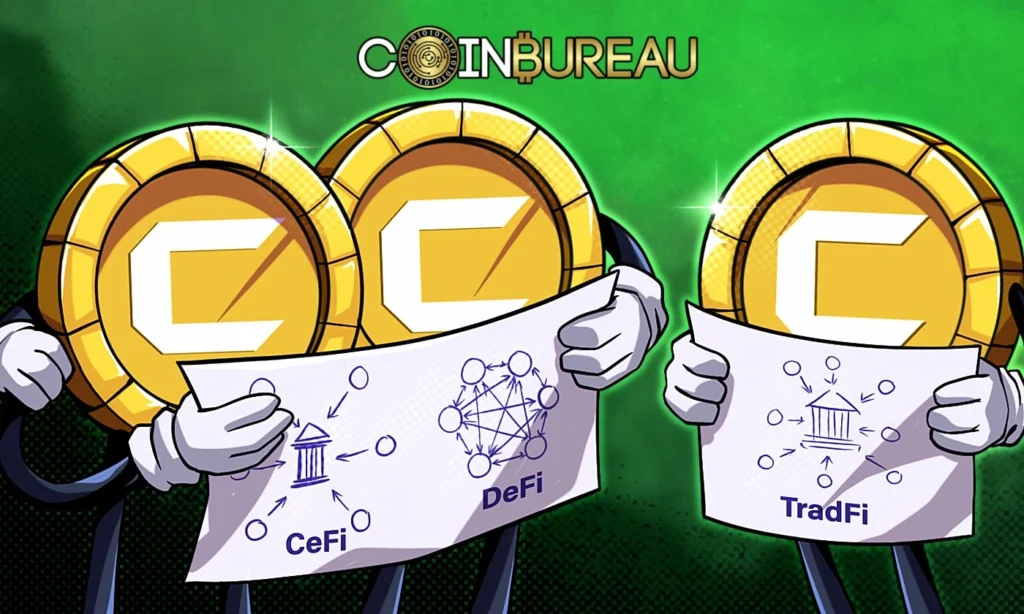DeFi vs CeFi vs TradFi: One Investor’s Eye-Opening Discovery
When Alex first heard the terms DeFi vs CeFi vs TradFi, it sounded like a tongue-twister—or maybe a new Marvel trilogy. It didn’t help that their finance knowledge barely extended beyond a savings account and a dusty student loan.
But curiosity has a funny way of taking over.
It started with a late-night rabbit hole on crypto Reddit. What began as casual browsing turned into a deep dive into financial systems that—frankly—felt more like science fiction than savings plans. Blockchain? Smart contracts? Self-custody wallets? Alex was intrigued… and a bit overwhelmed.
Still, they kept going.
Step One: Learning the Language of DeFi vs CeFi vs TradFi

Before understanding the risks, Alex had to learn the acronyms. And that meant deciphering the differences between TradFi, CeFi, and DeFi.
- TradFi was the familiar one—banks, brokerage firms, institutions with marble floors and overdraft fees. Safe, slow, and frankly, a little stale.
- CeFi sounded like TradFi’s crypto cousin. Centralized platforms like Binance and Coinbase—digital, but still managed by someone in charge.
- DeFi? That was the wild card. No gatekeepers, no customer support lines. Just users, smart contracts, and blockchains making it all tick.
At first, Alex loved the idea of DeFi. Total control? No middlemen? It felt like financial freedom.
The Trust Issue: One Transaction at a Time
Then reality hit.
While exploring DeFi, Alex lost $400 worth of tokens in a liquidity pool gone wrong. There was no one to call. No refunds. Just lesson learned.
It made them appreciate the structure of CeFi—at least platforms like Coinbase had customer support, and they didn’t need to remember a 12-word seed phrase every time they logged in. Sure, it wasn’t fully decentralized, but it felt like a smoother ride.
And when it came time to apply for a home loan, it wasn’t DeFi or CeFi that came through—it was TradFi. Bank statements, pay stubs, credit scores… the whole nine yards. Annoying, but necessary.
Alex realized then that this wasn’t a matter of “which one is better.” It was more about where each system fits in.
The Pros and Cons—Through Alex’s Eyes


Through trial (and error), Alex figured out a few core takeaways:
- TradFi is steady. Not exciting, but reliable—especially when it comes to big life stuff like mortgages and government oversight.
- CeFi is convenient. It’s crypto without chaos. But it still asks you to trust someone else with your assets.
- DeFi is empowering. It’s transparent and innovative, but risky and responsibility-heavy. Not for the faint of heart.
That first lost transaction? It stung. But it taught Alex more about personal finance than any bank brochure ever did.
The Bigger Picture: A Financial Blend in the Making


As Alex’s financial confidence grew, so did their perspective. They began to see the overlaps forming.
TradFi institutions were experimenting with blockchain. CeFi apps started offering DeFi features. Even DeFi protocols were softening, adding insurance layers and compliance tools.
It wasn’t about DeFi vs CeFi vs TradFi anymore—it was becoming DeFi and CeFi and TradFi. A mash-up of models, each taking cues from the others.
And while no system was perfect, the mix made sense. Just like no single tool can fix every problem, no single finance model fits every need.
Why DeFi vs CeFi vs TradFi Still Matters

Looking back, Alex doesn’t claim to be an expert. But they do know this: DeFi vs CeFi vs TradFi isn’t just a nerdy crypto debate—it’s a reflection of where money is heading, and who gets to participate.
It’s about control, trust, innovation… and knowing when to play it safe.
Now, Alex uses all three. A bank account for bills. A CeFi app for casual trading. And a little DeFi, because hey—once you’ve seen what’s possible, it’s hard to unsee it.
And that? That’s the new financial literacy.
Relevant News: HERE




